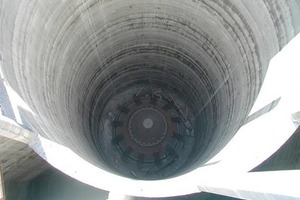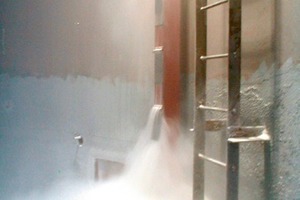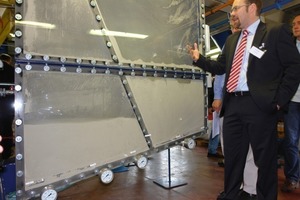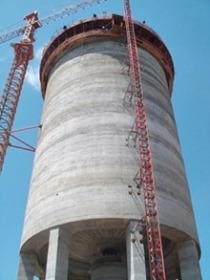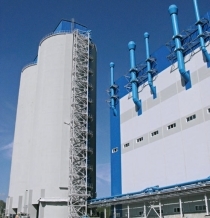Silo systems in theory and practice
Silo Open Day, Buxtehude/Germany (17.–18.09.2009)
In line with the tradition of the Open Days organized by Claudius Peters, the Silo Open Day 2009 took place at the headquarters in Buxtehude near Hamburg from 17th to 18th September 2009. About 150 interested customers and experts accepted the invitation of the North German company. After an evening at the Buxtehude brewery, where already many topics were discussed and new contacts made, the following Open Day was largely devoted to silo technology and bulk solids systems.
After the welcoming speech by R. Frühling, managing director of Claudius Peters Group GmbH since 1st January 2010, R. Bernasconi started with the first lecture dealing with the topic “Case history – inspection chamber silos at Holcim Siggenthal”. The Siggenthal cement works was founded in 1912. Since 1992 it has belonged to Holcim. An increase in capacity of the works to 2300 t/d had been planned for the period 2004 – 2008. The existing silo capacity was not sufficient for this extension, particularly as the existing silos 1–9 had reached the end of their service life and could no longer be used to its full capacity. One of the most important requirements was a storage capacity of at least 5 workdays for each cement type. First, two silos for truck dispatch were built. The second step was the construction of a multi-compartment silo (Fig. 1) for railway dispatch with a capacity of 10 590 m³. The multi compartment silo is equipped with an inspection chamber underneath the cone. The inspection chamber is used on the one hand to relief the discharge from the bulk material pressure and on the other hand to place equipment (e.g. filter) underneath the cone. The inspection chamber makes it possible to monitor even the filled silo. In order to achieve a short completion period, the inspection chamber was cut to 23 parts in the workshop, which were transported to the erection site of the silo and re-assembled there. After commissioning, no coating occurred in the silo and the reclaim rates amounted to far more than 99 %. A special program for silo discharge with different aeration of the individual chambers was used.
The second example from practice dealt with the production of aluminium. Are Dyroy and Morten Karlsen from Norsk Hydro ASA gave a lecture with the topic “Case history – anti-segregation systems when producing aluminium”. In this presentation possibilities were described to avoid segregation by means of the AS System© (Fig. 2) when filling and discharging silos with aluminium oxide. Since the manufacturing process of the metal aluminium is decisively influenced by the raw material handling, silo storage is one of the most important items for process optimization. The installation of an AS system© on existing silo plants was demonstrated by numerous examples.
D. Kennedy from Prostruc Consulting Engineers/Australia presented a project of the Melbourne Cement Facilities in his lecture “Application of expansion chamber principle to upgrade large cement silo – civil design construction”. There the reclaim rate from the silo with a capacity of 40 000 t as well as the actual silo discharge should be improved. The discharge system used so far no longer corresponded to the current technical demands. The final design provided the installation of a cone and a radially aligned tunnel (Fig. 3). Modular steel structures and shotcrete were used for the installation of these inserts. Approximately 4 weeks after the first filling, the silo could be used normally. Together with an aeration system arranged beneath the inserts, these conversion measures led to increase the discharge rate from 110 t/h to 175 t/h. The reclaim rate also amounted to more than 99 %.
Dr.-Ing. M. Kaldenhoff from HHW+Partner not only described the development and peculiarities of the standardization of silos, in the formulation of which he actively took part, but also showed impressive examples of damage caused by eccentric discharge in his lecture “Statical design of large silos with eccentric loads under applicable standards”. Based on theoretical considerations he explained the damage which occurred and how it could be avoided.
After the first part of lectures the participants had the opportunity to visit the manufacturing department and the pilot plant in the afternoon. In particular the pilot plant offered many interesting approaches for questions and discussions. There the different discharge behaviours of bulk solids were demonstrated by the example of a flat “silo slab” of acrylic glass that was especially constructed for the Open Day (Fig. 5). Amongst other things, the pilot plant facilities are used by graduands and doctoral candidates to carry out practical tests on silos, mills and conveying equipment.
After an interesting North German evening in Stade with many thought-provoking discussions, also the next day started with a mix of lectures and a plant tour with workshop character.
A. Hilck from Claudius Peters (CP) reported on
the “CP silo technology” based on clear facts. In over 100 years CP has built more than 3000 silos all over the world with capacities from 1000 to 60 000 m³. More than 13 000 different bulk solids have been tested in CP’s pilot plant to find out the material characteristics for the storage in silos. The tests comprise the particle-size distribution, the flowability, the aeration properties as well as other physical properties. After these tests, a storage classification according to Geldart, Jenike or Hilfgraf can be made. The following three criteria are important for the design of silos: minimization of the dead stock, constant discharge and low transfer of force to the silo structure. Further essential criteria for the design of silos are the right configuration of the cone inclination, the distance between cone and silo wall, the inclined, aerated silo bottom, the aeration in sections of the outer segment and of the silo chamber, the constant material handling as well as the dust collection equipment. Then Hilck presented the various types of silos from CP (Fig. 6) as well as an intelligent silo process control system.
“Modular system components – general overview of silo discharge systems” was the title of the lecture given by Y. Lattemann. The lecturer started with the silo discharge systems, presented various alternatives and explained them with practical examples (Fig. 7). Furthermore, he showed which process parameters have what effects on the discharge capacity. The design and mode of operation of flow control gates was also described comprehensively. In addition, he described the Multi Flow Elements (MFE) and finally the silo dispatch systems of CP making a distinction between mobile and stationary systems.
The series of lectures was concluded with the contribution “Packing & Dispatch – Packing Plants for the Cement Industry”, presented by B. Lübbert from Claudius Peters. The over 170 packing plants installed so far all over the world have a capacity of up to 4800 bags per hour. CP offers both rotary packers with a capacity of up to 4500 bags/hour and in-line packing machines for up to 1500 bags/hour. The modular design permits an easy exchange of the modules, e.g. for upgrading, and leads to lower maintenance costs. The equipment following the packing machines are also manufactured by CP, such as for the bag discharge systems and bagged truck loader.
Finally the participants had the opportunity to obtain comprehensive information about the production facilities within the framework of a plant tour through the individual workshops. Many questions were asked and the mode of operation of the individual machines was discussed very comprehensively. These were two days with a lot of information, new insights and intensive discussions for the participants. A worthwhile open day for all those taking part!

